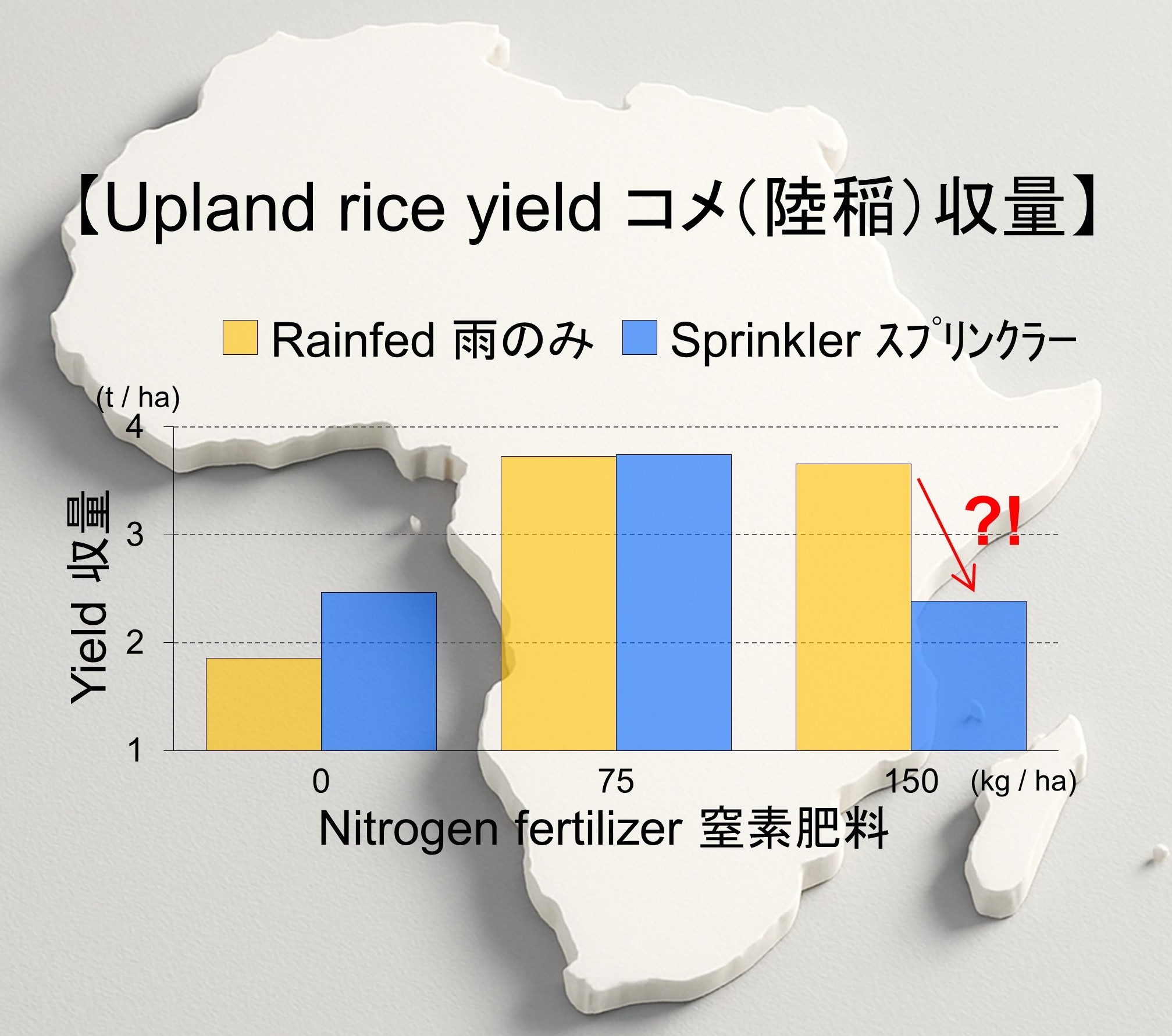ケニヤで取り組んだ陸稲栽培に関する研究がField Crops Research誌に掲載されました。
Sekiya et al. (2025) Effects of nitrogen application in upland rice cultivars: Balancing sink-source relationships for sustainable yield in water-limited environments. Field Crops Research 332 110012
コメは世界人口の半数以上が主食としている重要な作物です。なかでも陸稲は半乾燥地域における食料安全保障において重要な役割を果たしています。陸稲は灌漑せずに栽培され、世界のコメ作付面積の約8%を占めていますが、サブ・アフリカではそれが32%まで上昇し、この地域の食料安全保障において重要な役割を担っています。
私たちは三重大学の研究グループ(国際資源植物学+草地・飼料生産学)は、名古屋大学、東京農業大学、ダルエスサラーム大学(タンザニア連合共和国)、ケニア農業畜産研究機構(ケニヤ共和国)と共同で、半乾燥ケニアにおいて2年間にわたって陸稲栽培試験を実施しました。その結果、10aあたり窒素肥料7.5㎏で最高収量となる一方で、15㎏まで窒素肥料を増加させると、収量が低下する事実を発見しました。さらに驚くべきは、窒素肥料と灌漑の組み合わせで増収するという一般常識に反し、「高窒素×灌漑」で減収が助長されることを立証したのです。この現象は日本の陸稲品種ユメノハタモチで顕著に現れ、アフリカの陸稲品種NERICA1では顕著に現れませんでした。
研究グループは、高窒素で栽培された陸稲が茎葉部へ優先的に光合成産物を分配するように体内生理を変化させるため、結果的に玄米の充実が阻害されることを突き止めました。さらに、この現象が灌漑によって助長されるため、「高窒素×灌漑」で減収が助長されることも立証しました。
これらの新知見は、肥料と灌漑の組み合わせが相乗効果を生み出すという常識の見直しを迫ります。また、アフリカで育成されたNERICA1の安定性は、品種選択の重要な指針となるでしょう。
サブ・サハラアフリカの陸稲は生産者の経験に依存して生産されてきましたが、本研究の成果は科学的な根拠に基づいた陸稲栽培技術の指針確立に大きく貢献することが期待されます。その技術指針は、共著者のネットワークを通じて、直接的に東アフリカ諸国へ普及することが期待されます。また、三重大学とJICAは、国際資源植物学研究室の在学生や卒業生を海外協力隊としてガーナへ派遣しており、この連携派遣を通じで西アフリカ諸国への技術普及も期待されます。
Published Paper: New Findings in Upland Rice Physiology
Our research on upland rice cultivation conducted in Kenya has been published in Field Crops Research.
Sekiya et al. (2025) Effects of nitrogen application in upland rice cultivars: Balancing sink-source relationships for sustainable yield in water-limited environments. Field Crops Research 332 110012
Rice is a crucial crop that serves as the staple food for more than half of the world’s population. Among rice cultivation systems, upland rice plays an important role in food security in semi-arid regions. Upland rice is cultivated without irrigation and accounts for approximately 8% of the world’s rice cultivation area. However, in sub-Saharan Africa, this proportion rises to 32%, making it a vital component of food security in the region.
Our research group at Mie University (Global Plant Resource Science + Grassland and Animal Feed Production) conducted upland rice cultivation trials in semi-arid Kenya for two years in collaboration with Nagoya University, Tokyo University of Agriculture, University of Dar es Salaam (Tanzania), and Kenya Agricultural and Livestock Research Organization (Kenya). Our results revealed that the maximum yield was achieved with 7.5 kg of nitrogen fertilizer per 10 ares (0.1 hectare), while increasing nitrogen fertilizer to 15 kg resulted in yield reduction. Even more surprising, contrary to the common belief that the combination of nitrogen fertilizer and irrigation increases yield, we demonstrated that “high nitrogen × irrigation” actually accelerated yield reduction. This phenomenon was prominent in the Japanese upland rice variety Yume-no-Hatamochi but was not pronounced in the African upland rice variety NERICA1.
The research group discovered that upland rice grown under high nitrogen conditions altered its internal physiology to preferentially allocate photosynthetic products to stems and leaves, consequently inhibiting grain filling. Furthermore, we demonstrated that this phenomenon was enhanced by irrigation, thus proving that “high nitrogen × irrigation” accelerated yield reduction.
These new findings challenge the conventional wisdom that the combination of fertilizer and irrigation produces synergistic effects. Additionally, the stability of NERICA1, developed in Africa, provides important guidance for variety selection.
Upland rice production in sub-Saharan Africa has traditionally relied on farmers’ experience, but the results of this study are expected to make significant contributions to establishing scientific evidence-based guidelines for upland rice cultivation techniques. These technical guidelines are expected to be directly disseminated to East African countries through the network of co-authors. Furthermore, Mie University and JICA have been dispatching current students and graduates from the International Plant Resource Science laboratory to Ghana as overseas cooperation volunteers, and through this collaborative dispatch program, technical dissemination to West African countries is also anticipated.





 using WordPress and
using WordPress and
Comments are closed